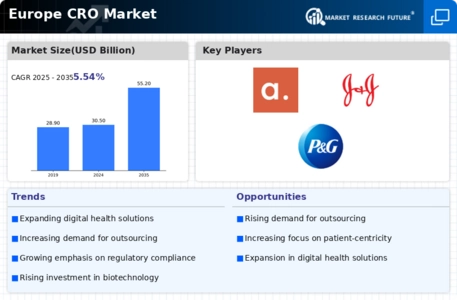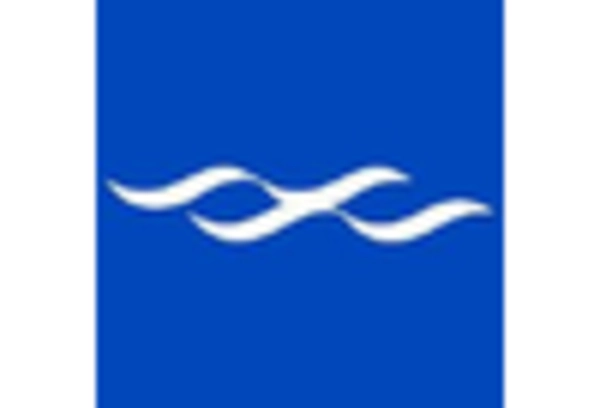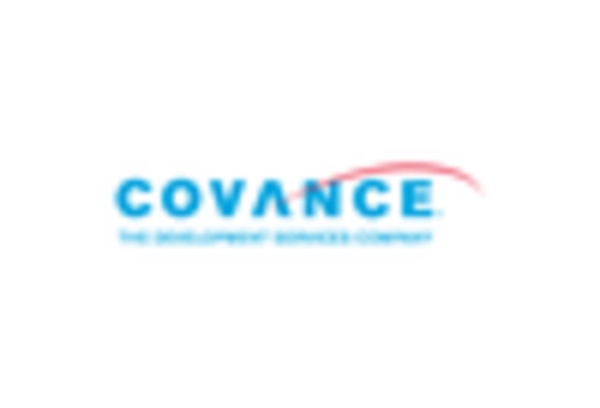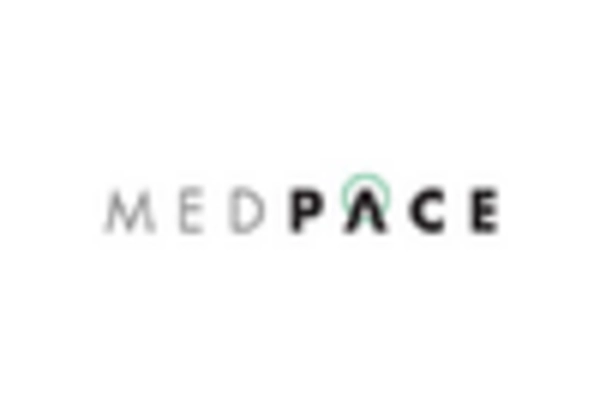Increased Investment in Biotechnology
Increased investment in biotechnology is a key driver of the Europe CRO Market. As venture capital and private equity funding flow into biotech firms, the need for outsourced research services is surging. In 2025, the European biotechnology sector is expected to witness significant growth, with numerous startups emerging to develop innovative therapies. This influx of investment is likely to result in a higher demand for CROs that can provide comprehensive support throughout the drug development process. Additionally, established pharmaceutical companies are increasingly collaborating with CROs to leverage their expertise in navigating the complexities of biotech research. As a result, the increased investment in biotechnology is fostering a symbiotic relationship between CROs and biotech firms, thereby propelling growth within the Europe CRO Market.
Growing Demand for Personalized Medicine
The growing demand for personalized medicine is significantly influencing the Europe CRO Market. As healthcare shifts towards more tailored treatment approaches, CROs are adapting their services to meet the unique needs of patients. In 2025, the market for personalized medicine is projected to reach substantial figures, prompting pharmaceutical companies to invest in research and development. This trend necessitates specialized CROs that can conduct complex trials focused on specific patient populations. Furthermore, the emphasis on biomarkers and genetic profiling is driving the need for CROs with expertise in these areas. Consequently, the demand for personalized medicine is not only reshaping clinical trial designs but also creating new opportunities for CROs to expand their service offerings within the Europe CRO Market.
Regulatory Compliance and Quality Assurance
The Europe CRO Market is experiencing a heightened emphasis on regulatory compliance and quality assurance. As pharmaceutical and biotechnology companies navigate complex regulatory landscapes, the demand for CROs that can ensure adherence to stringent guidelines is increasing. In 2025, the European Medicines Agency (EMA) continues to enforce rigorous standards, compelling organizations to seek external expertise. This trend is likely to drive growth in the CRO sector, as companies prioritize compliance to avoid costly delays and penalties. Furthermore, the emphasis on quality assurance is not merely a regulatory requirement; it is also a competitive differentiator. CROs that demonstrate robust quality management systems may attract more clients, thereby enhancing their market position. Consequently, the focus on regulatory compliance and quality assurance is a pivotal driver in the Europe CRO Market.
Technological Advancements in Clinical Trials
Technological advancements are reshaping the Europe CRO Market, particularly in the realm of clinical trials. The integration of artificial intelligence, machine learning, and data analytics is streamlining trial processes, enhancing efficiency, and improving patient recruitment. In 2025, it is estimated that over 60% of CROs are utilizing advanced technologies to optimize trial designs and data management. This shift not only reduces operational costs but also accelerates the time to market for new therapies. Moreover, the adoption of electronic data capture (EDC) systems and remote monitoring tools is becoming increasingly prevalent, allowing for real-time data collection and analysis. As a result, CROs that leverage these technologies are likely to gain a competitive edge, positioning themselves favorably within the Europe CRO Market.
Focus on Cost Efficiency and Resource Optimization
The focus on cost efficiency and resource optimization is driving transformation within the Europe CRO Market. As pharmaceutical companies face pressure to reduce R&D expenditures, many are turning to CROs to streamline their operations. In 2025, it is anticipated that the demand for cost-effective solutions will continue to rise, prompting CROs to innovate their service offerings. By outsourcing clinical trials, companies can access specialized expertise while minimizing overhead costs. Furthermore, CROs are increasingly adopting flexible pricing models to accommodate the varying budgets of their clients. This trend not only enhances the attractiveness of CRO services but also allows pharmaceutical companies to allocate resources more effectively. Consequently, the emphasis on cost efficiency and resource optimization is a crucial driver shaping the landscape of the Europe CRO Market.

















Leave a Comment